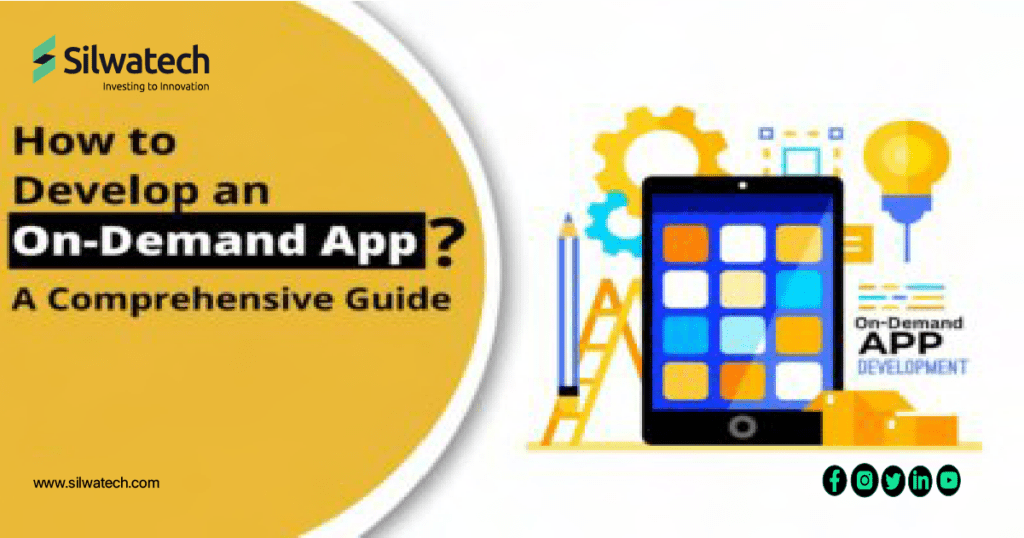Technology has changed the way customers interact with businesses. Earlier, if finding a new restaurant meant taking a chance and maybe eating bad food, today you just need to look up customer reviews from food delivery apps. You can place your order and be assured of good food delivered to your doorstep. How much more convenient can it get?
Now, all it takes is a click of a button to bring a business and a customer together. Simply download the app, and use their service. Be it groceries, food, clothes, or anything you can think of.
On-demand apps solve many of our problems in ways we never thought of before. A quick look at our smartphones will show how many on-demand or on-demand delivery apps we are already using.
This guide covers everything you want to know about on-demand app development – why you should consider it, how to build it, essential features, and cost. Let’s dive in without further ado!
Why Should You Consider Building Apps on Demand?
A business that owns an app provides more platforms for customers to interact with them. Those in the service industry or work from an office can easily create a new platform, thus increasing the chances of purchase and keeping ahead with the trends.
An on-demand app is an excellent way for businesses to be out there. In a time where there is an app for everything, you’re missing out on a significant opportunity if you do not create an online presence to reach out to customers who entirely resort to the online marketplace to make purchases. If you are a small business, you need to consider creating an on-demand app. With an on-demand app, your interactions with your customer increase from the simple ones at a brick-and-mortar store to more personalized ones. A customer can:
- Track orders, appointments, and bookings
- Explore products and offers
- Create an account and get personalized offers
- Contact the business directly for additional assistance
- Explore all services of a business
- Make transactions online via secure portals
What is an On-Demand Service?
On-demand apps are service platforms that deliver a service or product to a customer in a time-bound manner. The app serves as a mediator between the customer and the business. It allows them to find each other and engage in mutually beneficial business. It is vastly different from the traditional modes of transactions. Today, business, marketing, and transactions are conducted differently.
Because they can satisfy each individual’s demand, these applications have grown in popularity. Additionally, as the number of mobile users keeps increasing, user expectations shaped by this change have also increased to the point where users expect to get what they need at almost any time by tapping the screen a few times. There is no choice but to adhere to the standards because they have been set so high.
On-Demand Apps and Their Popularity
One of the reasons on-demand apps have grown in popularity is that it is highly convenient. This proved especially true during the covid pandemic that affected the whole world. Here are some features that made them grow increasingly popular posts covid.
- Extensive Features
The fact that business resumed but with more features enabled transactions to happen without losing quality. People didn’t have to compromise on the services they used to get because of the lockdown. On-demand, apps provided a newer way to carry them out. Features like cart, checkout, dashboard, price comparison, and more made shopping online more pleasurable and convenient.
- Contactless Delivery
This was perhaps the biggest advantage on-demand apps had during the pandemic. It enabled the carrying out of business without contact. While people live in fear of spreading the deadly virus, they can always have the services they need at their doorstep without having to contact others. Conducting business was also made safe this way.
- Speedy Service
The need for businesses to deliver as soon as possible and the demand for such services made on-demand apps extremely popular. If you didn’t have something at your nearby store, there was always an app you could use to order. Be it from another state or another country, you could bring it to your doorstep at the fastest time possible.
How to Build an On-Demand App?
So what does it take to build an on-demand app? Here is a quick map of how to get from idea to implementation for an on-demand app.
- Find the area of business, know your target customer base
- Get a team to build the app
- Get project requirements and define a feature set
- Create an MVP or minimum viable product for running a test
- Find your monetisation strategy
- Test the app thoroughly and run it through our customers
- Develop the on-demand app with the entire set of features
- Track your KPIs and market your app aggressively
This is the most simplified form of the outline of on-demand app development. You can add as many steps as you need to these. The steps can also vary depending on the type of project. But be careful not to skip any of these as these are the absolute must.
On-Demand Service App Development: Types of On-Demand Apps
If you plan to build an on-demand app, you should know the different types of on-demand apps. It can be divided into three major groups.
- Business To Business
On-demand service apps for B2B connect one enterprise to another. They may be suppliers, maintenance companies, providers, etc. An on-demand app can provide a seamless customer experience and high customer satisfaction.
- Business To Consumer
A business can also create an on-demand app to distribute its goods and services through an app. The customer has to download the app and can then access the services or products. There may be only one vendor or multiple vendors on the platform.
- Person To Person
As the name suggests, the platform allows people to transact between them. An enterprise will enable these platforms. Car-sharing facilities are one such example.
Things to Keep in Mind for On-Demand App Development
Before you start your on-demand app development, here are some points you have to keep in mind.
1. What is the Problem You are Solving?
What is the pain you are addressing using the app you develop? Does it provide a service or a product? Is it commonly used, or is only used once in a while?
There are many apps with services like food delivery, mobile recharge, hotel rooms, job listing etc. These may be considered real problems and cannot be neglected. However, your idea may not work out if you choose to address an issue that is not as commonly used or not a real issue. You must do thorough research before fixing an idea.
2. Who is your Expected Customer Base?
This is another vital aspect of your business journey. Know exactly who your customer base is. Once you have that cleared and out of the way, you can tailor the rest of your features according to the expected customer base. Without a proper audience, your product or service may be too vague.
3. Study the market and trends
Without studying the market and trends properly, your app risks fizzling out even before it launches. Does your product have a market fit? Will it be incorporated into the market, and will the expected customer base accept it? Are you following a trend, or does it have longevity?
4. The psychology of convenience
Does your app make it more convenient for your customer, or do they have to go out of their way to get your product or service? You are off to a good start if it adds to their convenience. With features like doorstep delivery, reviews and ratings, payment portals, tracking delivery etc., the customers are more at ease, adding to their convenience.
5. Suppliers
When connecting a business to a customer, there is the invisible but vital presence of the suppliers. There is no point running a taxi booking app if you do not have taxis at your call, a shopping app without the products at a warehouse. A dedicated list of suppliers for your services is the backbone of a service or product on-demand app.
6. The technology that enables business
As a business, you will have heard of how algorithms influence business decisions. It is a tricky concept to understand by an easy and competitive issue to track down. With the proper marketing and through the proper channels, you can ensure that you can top the algorithm and make it favorable to your cause.
The Most Essential Features of On-Demand Apps
An app’s features make it attractive and valuable to a customer. Considering there is a customer’s app, a service provider’s app, and an admin app, here are the features you need to include which are vital for the proper functioning of the app.
Customer’s App
- Order Details to know what they have ordered at present or previously
- Real-time Order Tracking to get real-time updates
- Payment Integration for safe and reliable online payment
- Review and Ratings to leave feedback as well as to know other customers’ experience
- Customer Support to ensure your customer is valued
Service Providers’ App
- History of Order to know the details of the delivery
- Payment History to keep track of wages, tips, commissions etc.
- Vehicle Details of the delivery personnel
- Accept or Reject Delivery Tasks according to the availability and convenience of the delivery personnel
- Google Map Integration to find the shortest way to deliver a product
Admin App
- Details of the Delivery Person to keep track of all employees
- Order Tracking to record delivery personnel performance
- Management of Payment of fees, salaries etc
- Order History of all upcoming and past deliveries
Cost-Driving Factors of On-Demand App Development
The cost of developing an app depends upon many features, requirements, project size, etc. The wireframe, prototype, design, development and maintenance can all have different costs depending on the project size. Here is a demarcation of the different features, which can help you figure out how the cost would rise accordingly.
The Basic Features:
These include order tracking, order history, payment options, etc. They cannot be skimped as they are the core of the app. The cost of these can be the base cost.
The Advanced Features:
They are add-on features that can make your app stand out from the rest, but without them, the app’s functioning is unaffected. AR integration, in-app calls, push notifications etc., are such features.
Other factors that affect the cost of on-demand app development are the platform in which it is being developed, either iOS or Android. The development team hiring model also determines the cost. Whether you make an in-house team or hire externally affects the cost significantly.
Get Cost Estimation of Your On-Demand App
Say you have a splendid idea for a business, one that is a product or service delivery one. But implementing it would require a fully decked app. Besides an app, it would require extensive marketing and planning.
There are a lot of skills required to do all of this. From coding to marketing, there is an expert required for every aspect. There is also the risk involved. Not to mention the expenses of doing all this. In such instances, on-demand app development services like Silwatech come into the picture.
With an expert like Silwatech, you need not create a team from scratch. Silwatech has teams of expert app developers who have rich experience and great rapport in working together and working with you with a better understanding. If you need to know the cost estimation of developing an on-demand app for your business, you must reach out to us through our website or phone number, and we will get back to you.




















